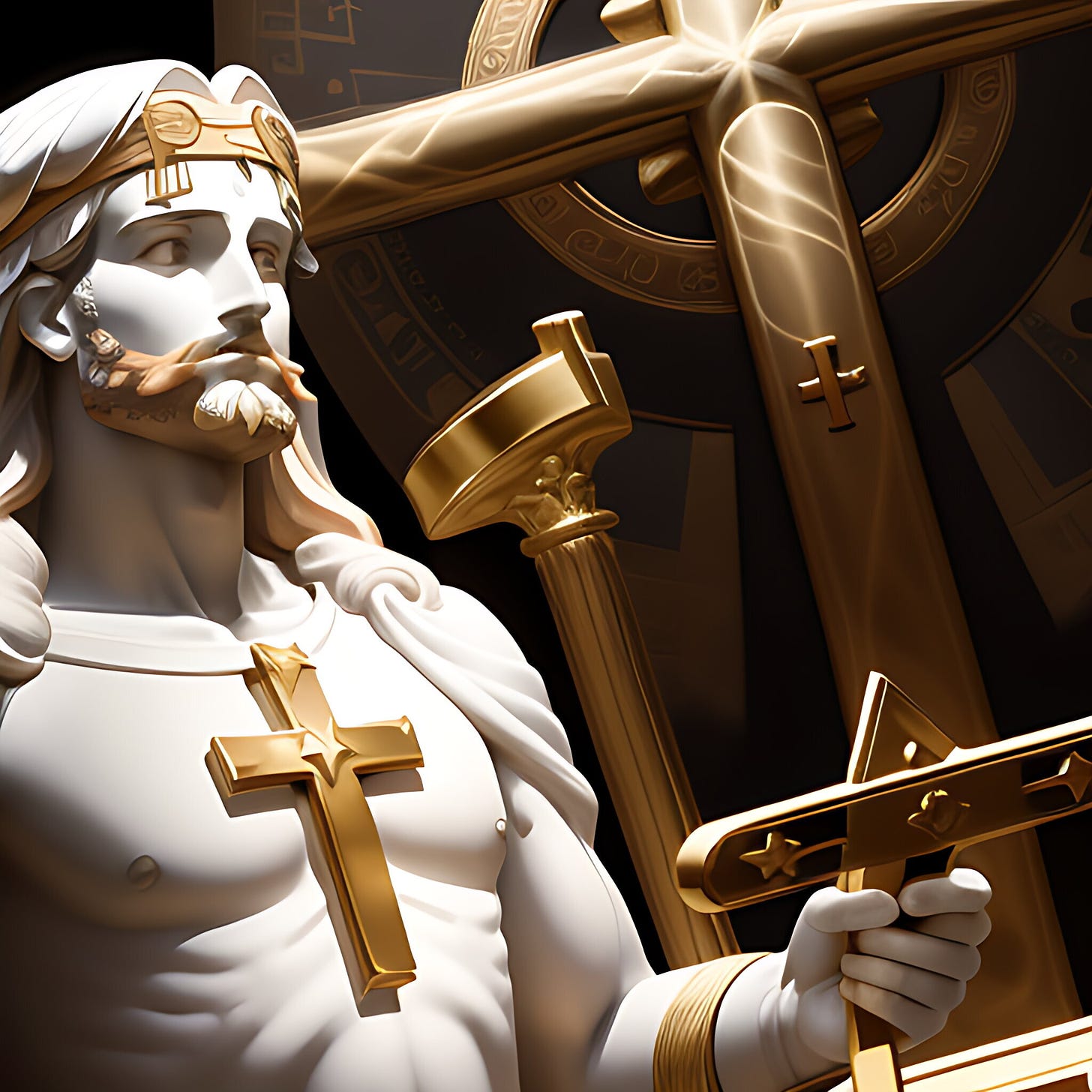Syncretism
Satan seduces the church inch by inch, compromise by compromise, surrender by surrender, until at last she has completely betrayed her Lord.
Dear friends and supporters:
Syncretism is the blending of religions. In the words of Imbach, it’s “[t]he process by which elements of one religion are assimilated into another religion resulting in a change in the fundamental tenets or nature of those religions.”1[1] The ancient world was deeply syncretistic because it was pervasively polytheistic — many gods, many religions. Almost every culture worshipped more than one god. In fact, some cities and even families had their own unique gods. These gods were thought to provide material sustenance and protection, so the more gods, the better. This is the basic rationale for pagan syncretism.
Israel was a striking exception. They served the one and only true God of heaven and earth, who demanded absolute, unqualified allegiance: “You shall worship the Lord your God, and him only shall you serve” (Lk. 4:8). Tragically, the Jews broke this law — and God’s heart — again and again. Just after they were formalized as a nation (Ex. 19, 24), they urged Moses’ brother Aaron to fashion a golden calf they could worship after they lost patience with Moses atop Mount Sinai receiving God’s law. The Jews aped the nations surrounding them, like Egypt, which they’d just left behind.
The subsequent history of Israel is largely a history of syncretism. From the settling of Canaan in the time of the judges until their brutal resettlement by Assyria and Babylon, they consistently adopted pagan gods (like Baal and Moloch) while giving lip and liturgical worship to the true God.
The coming of our Lord and his blood atonement and bodily resurrection established the new covenant people of God and purged almost all syncretism from that visible apostolic body. While the churches at Colosse and Pergamum wrestled with idolatry and early Gnosticism afflicted others, Jesus Christ knocked syncretism back on its heels.
Patristic Syncretism
That happy state wasn’t to last. The new syncretism was more abstract than its Old Testament version: the syncretism of the post-apostolic and pre-medieval times (patristic) was driven more by pagan philosophy than its polytheism. A number of church fathers were heavily influenced by the dominant Greek philosophy, as in Plato and Aristotle, and welded it to the biblical gospel. The Greek philosophers saw God as an abstract principle, deeply impersonal.
The church fathers adapted this conception to create “classical theism,” positing the biblical God as unmoved and unmoving, static and without emotions. They were so anxious to construct the highest God they could conceive of that they constructed a non-biblical god.
Similarly, like the Greek dualists, they saw the material world as inferior to the non-material and embraced a debased view of the human body, sex, food, and other material creational benefits. They constructed a two-tiered spirituality: the celibate priesthood and nunneries versus the sexually un-self-governed laity. They developed a system of monasteries and convents for the truly spiritual, while the mediocre non-clergy lived as best as they could in an evil world.2 This amalgam of Christianity and Greek philosophy set the stage for institutionalized syncretism.
A Blast Against Syncretism and Worldliness
Get the book here.
Medieval Syncretism
By the Middle Ages, the church had become a nest of syncretism. The elaborate sacramental system reflected pagan magic, with salvation dispensed at the hands of priests, and purgatory evaded by the payment of indulgences. In the ancient pagan world one could pay off the gods to snag favors, and in the medieval church indulgences filled that role. Marian devotion degenerated into a cultic goddess religion, as Mary became a co-mediatrix with Christ.
The liturgical movement of public worship within the syncretized institutional church smothered all of life. “Natural” theology — knowing reality without Christ and the Bible — governed everything outside the church.
The Reformation struck hard at this syncretism. God saves man solely in the redemptive work of Jesus Christ. Sinners are saved totally by Christ, not by the church or Mary or the saints. All of life must be governed by Jesus Christ, both inside and outside the church.3 But syncretism soon crept back into the Protestant churches, with man’s reason gradually supplementing and finally replacing God’s revelation as the authority (Protestant scholasticism and its child theological liberalism).
Modern Syncretism
The modern revival of ancient paganism (now neopaganism) recovered “spirituality,” the union of man with nature as the new deity. To some radically environmental neopagans, nature is god and man must be eradicated to preserve the nature-deity.
The sexual side of neopaganism is the 20th century Sexual Revolution first exhibited in recreational birth control and a “swinging” lifestyle. More recently it has degenerated into the legalization of same-sex “marriage” and “transgenderism.” The syncretistic move of the church has been to give up prohibition of premarital sex and become LGBTQI+ “affirming.” “Transgenderism” has infiltrated even the evangelical church, which has now made its peace with the ancient pagan “nonbinary” sexuality.
All of the synchronism isn’t on the Left, however. Male Christian singles have devised a Christian veneer for the Bronze Age Mindset, a book and movement reviving ancient paganism in the form of body worship (the weightlifter’s life), machismo (women as sex objects), and statism (capture politics to crush the Left). The Christian version, the neomasculinity movement, drops the most egregious elements of BAM and accommodates Christianity to the rest. Older faithful, wise Christian men they consider sellouts (“OK, Boomer”), and they aim to fashion a near-fascist “Christian” state. Syncretism in the modern church is both Left and Right.
Conclusion
“The Bible,” Imbach again writes, “reveals syncretism as a long-standing tool of Satan to separate God from his people. It strikes at the heart of the first commandment.”4 Syncretism cannot be addressed gently and incrementally. It must be ripped out at the roots. In our individual lives, we must constantly be on guard against casually assimilating the neopaganism surrounding us — “Homosexuality isn’t for me, but we need to get used to it”; “I’ll be a good Christian on Sunday, but the rest of the week is mine”; “God wants me to be buff and beautiful and virile and domineering.” No. The Bible alone is our standard. Anything else invites syncretism.
Church leaders must constantly be on guard against syncretism, because it’s the default expression of apostasy in a time of radical individual autonomy. Satan ordinarily doesn’t tempt the church to abandon the Faith wholesale. Rather, he seduces the church inch by inch, compromise by compromise, surrender by surrender, until at last she has completely betrayed her Lord.
The supreme goal of the church is always love for and loyalty to her Lord. This means utter repudiation of syncretism.
Personal
This weekend I’m conducting the wedding for my long-time friend Annie Souther and her dear husband-to-be Josh Florez. Few acts in life rejoice my heart more than conducting and attending Christian weddings, particularly in our present culture that dismisses and degrades marriage.
I’m working on the essay collection The Sanctified State: Politics in the Christian Worldview. In addition to me, contributors include David Bahnsen, Joe Boot, George Grant, Brian Mattson, Levi Secord, and Jeffery Ventrella. It should be ready by early December. I hope to get the collection of John Frame’s sermons, Widen Your Hearts, out by next spring. That project is taking much longer than I'd hoped.
The next post planned for CultureChange is “Neither Marxist Nor Fascist: A Cautionary Tale from Weimar.”
Thank you deeply for your support and friendship.
Yours for the cosmic Lord,
Founder & President, Center for Cultural Leadership
Isaiah 49:1–2
A Discussion on Classical Liberalism
Watch here.
More great stuff
The Center for Cultural Leadership site is here.
My Amazon author page (print and digital) is here.
My I-Tunes sermons, lectures and podcasts are here.
You can find my sermons and lectures at my YouTube channel.
Sign up to get my blog updates here.
Here’s my Twitter feed.
If you want to get the free exclusive hard copy publication Christian Culture, please send me a Facebook private message.
The CCL phone number is 831-420-7230.
The mailing address is:
Center for Cultural Leadership
P. O. Box 100
Coulterville, CA 95311
S. R. Imbach, “Syncretism,” Evangelical Dictionary of Theology, Walter A. Elwell, ed. (Grand Rapids: Baker, 1984), 1062.
Michael W. Kelley, The Impulse of Power (Minneapolis, Minnesota: Contra Mundum, 1998), 100–106.
Luther and even Calvin were inconsistent on this theme, but the Puritans and especially Reformational thinkers like Abraham Kuyper recovered the biblical conception.
S. R. Imbach, “Syncretism,” 1062.







